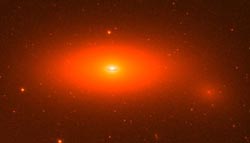Giant black hole could upset galaxy evolution models

Image of the disk galaxy (lenticular galaxy) NGC 1277, taken with the Hubble Space Telescope. This small, flattened galaxy contains one of the biggest central super-massive black holes ever found in its center. With the mass of 17 billion Suns, the black hole weighs in at an extraordinary 14% of the total galaxy mass.<br><br>Image credit: NASA / ESA / Andrew C. Fabian / Remco C. E. van den Bosch (MPIA)<br>
To the best of our astronomical knowledge, almost every galaxy should contain in its central region what is called a supermassive black hole: a black hole with a mass between that of hundreds of thousands and billions of Suns. The best-studied super-massive black hole sits in the center of our home galaxy, the Milky Way, with a mass of about four million Suns.
For the masses of galaxies and their central black holes, an intriguing trend has emerged: a direct relationship between the mass of a galaxy's black hole and that of the galaxy's stars.
Typically, the black hole mass is a tiny fraction of the galaxy's total mass. But now a search led by Remco van den Bosch (MPIA) has discovered a massive black hole that could upset the accepted relationship between black hole mass and galaxy mass, which plays a key role in all current theories of galaxy evolution. The observations used the Hobby-Eberly Telescope and existing images from the Hubble Space Telescope.
With a mass 17 billion times that of the Sun, the newly discovered black hole in the center of the disk galaxy NGC 1277 might even be the biggest known black hole of all: the mass of the current record holder is estimated to lie between 6 and 37 billion solar masses (McConnell et al. 2011); if the true value lies towards the lower end of that range, NGC 1277 breaks the record. At the least, NGC 1277 harbors the second-biggest known black hole.
The big surprise is that the black hole mass for NGC 1277 amounts to 14% of the total galaxy mass, instead of usual values around 0,1%. This beats the old record by more than a factor 10. Astronomers would have expected a black hole of this size inside blob-like (“elliptical”) galaxies ten times larger. Instead, this black hole sits inside a fairly small disk galaxy.
Is this surprisingly massive black hole a freak accident? Preliminary analysis of additional data suggests otherwise – so far, the search has uncovered five additional galaxies that are comparatively small, yet, going by first estimates, seemed to harbor unusually large black holes too. More definite conclusions have to await detailed images of these galaxies.
If the additional candidates are confirmed, and there are indeed more black holes like this, astronomers will need to rethink fundamentally their models of galaxy evolution. In particular, they will need to look at the early universe: The galaxy hosting the new black hole appears to have formed more than 8 billion years ago, and does not appear to have changed much since then. Whatever created this giant black hole must have happened a long time ago.
Contact
Remco van den Bosch (first author)
Max Planck Institute for Astronomy
Heidelberg, Germany
Phone: (+49|0) 6221 – 528 381
Email: bosch@mpia.de
Arjen van der Wel (co-author)
Max Planck Institute for Astronomy
Heidelberg, Germany
Phone: (+49|0) 6221 – 528 461
Email: vdwel@mpia.de
Markus Pössel (public relations)
Max Planck Institute for Astronomy
Heidelberg, Germany
Phone: (+49|0) 6221 – 528 261
Email: pr@mpia.de
Media Contact
All latest news from the category: Physics and Astronomy
This area deals with the fundamental laws and building blocks of nature and how they interact, the properties and the behavior of matter, and research into space and time and their structures.
innovations-report provides in-depth reports and articles on subjects such as astrophysics, laser technologies, nuclear, quantum, particle and solid-state physics, nanotechnologies, planetary research and findings (Mars, Venus) and developments related to the Hubble Telescope.
Newest articles

First-of-its-kind study uses remote sensing to monitor plastic debris in rivers and lakes
Remote sensing creates a cost-effective solution to monitoring plastic pollution. A first-of-its-kind study from researchers at the University of Minnesota Twin Cities shows how remote sensing can help monitor and…

Laser-based artificial neuron mimics nerve cell functions at lightning speed
With a processing speed a billion times faster than nature, chip-based laser neuron could help advance AI tasks such as pattern recognition and sequence prediction. Researchers have developed a laser-based…

Optimising the processing of plastic waste
Just one look in the yellow bin reveals a colourful jumble of different types of plastic. However, the purer and more uniform plastic waste is, the easier it is to…


